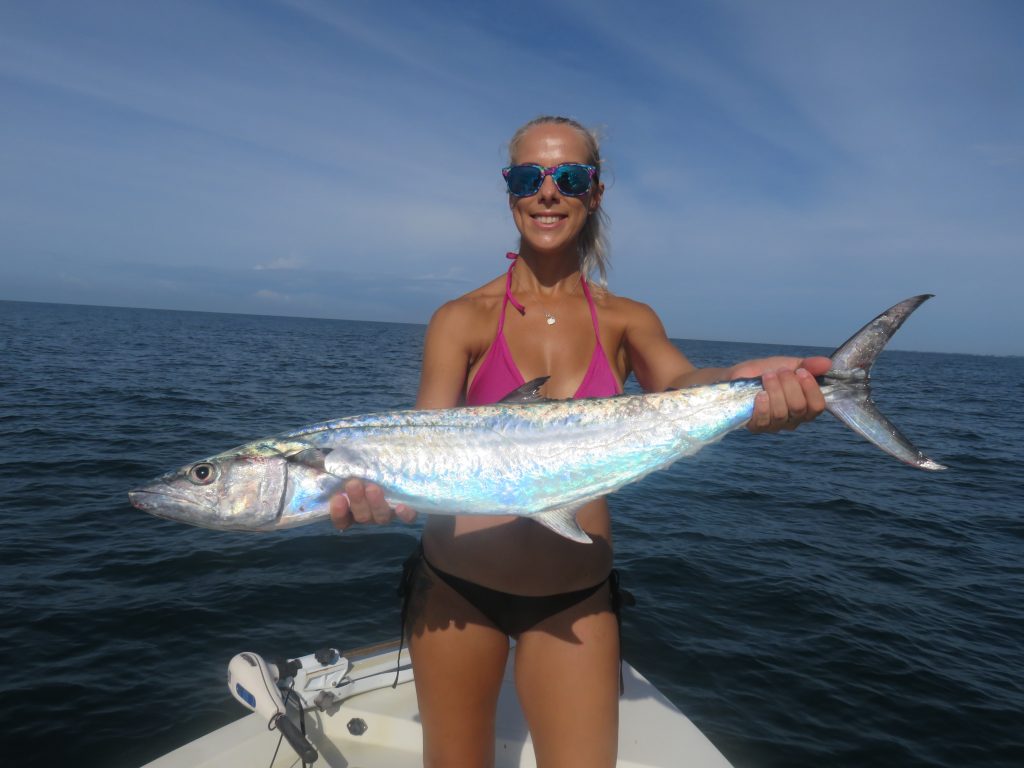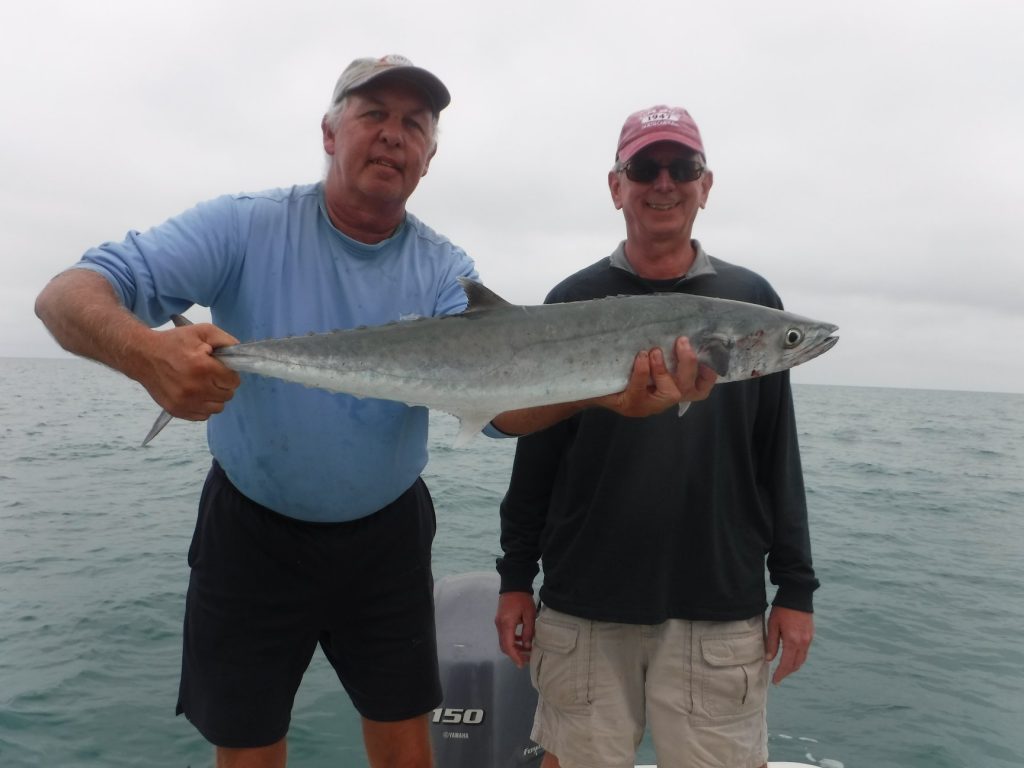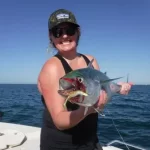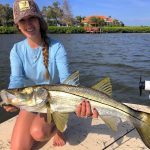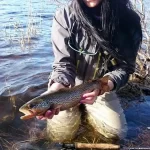Florida King Mackerel Fishing Tips
This article covers Florida king mackerel fishing. King mackerel are a very popular game fish. They are found in the coastal waters all along the entire Gulf of Mexico coast and up the East Coast of the United States to the mid Atlantic. They are also plentiful in the Caribbean.
King mackerel are a pelagic species. This means that they spend the majority of their time in the upper portion of the water column. They are constantly on the move, though they do relate to structure. King mackerel are one of the most popular offshore game fish in Florida. Their migration patterns mirror those of the bait fish that they feed on. The world record king mackerel is 93 pounds and was caught in Puerto Rico. Kings are very good to eat when prepared fresh, though they do not freeze well.
1) Finding bait is critical to catching king mackerel
King mackerel will never be very far from the groceries. They feed in schools in open water, foraging on bait fish. The type of fish they feed on will depend on location and time of year. Scaled sardines, threadfin herring, blue runners, cigar minnows, pogies, and mullet are just a few of the more popular bait fish species that king mackerel feed on. Bait schools can either be seen dimpling on the surface or located using a bottom machine.
King mackerel and other pelagic species will migrate with the bait. In the spring, the movement is north and in fall it reverses to the south. Some king mackerel will be caught in summer offshore. They are plentiful in the Florida Keys in the winter.
2) King mackerel love structure
While king mackerel are an open water fish, they will often times relate to some sort of structure. Part of the reason for this is that structure tends to attract the bait fish that they feed upon. Areas of hard bottom, ledges, reefs, wrecks, and oil rigs will all attract and hold kings. Generally speaking, structure in water depths between 30 feet deep and 75 feet deep are the best spots. However, they can be found right along the beach as well as very far offshore.
Wrecks and artificial reefs are plentiful off of both Florida coastlines. The most effective spots are generally in water that is between 40 feet and a hundred feet deep. The good news is that most of these spots are public knowledge. Anglers can easily find the GPS numbers online or at local government websites. When the kings are thick, it is easy to spot the cluster of boats around productive reefs.
Natural ledges should not be overlooked by anglers Florida king mackerel fishing! While these spots won’t usually hold the larger schools of kings, they also get less fishing pressure. An added bonus is that anglers can bottom fish for grouper and snapper while waiting for a king to show up in the chum. This is a great two pronged approach where anglers can bottom fish for snapper and grouper while free lining a bait out for king mackerel Live shrimp will work in this situation as well.
3) King mackerel fishing rods and reels
King mackerel are one of the fastest fish species in the sea. Large kings are called “smokers” because of their blistering initial runs that can literally “smoke” the drag. Reels, whether conventional or spinning, need to have a high capacity of line as well is a very smooth drag. Fast retrieve ratios are also helpful in retrieving the line back on the spool. King mackerel will often double back and swim towards the boat. They will often swim through the line, slicing it. A fast reel is very helpful!
Both spinning tackle and conventional tackle work fine for anglers Florida king mackerel fishing. Very seldom will casting be required. Most kings are caught by anglers trolling or free lining baits. Long, limber rods work best, especially when using live bait fish. Limber tips will help keep the small treble hooks that are used with stinger rigs in the fish. Stouter conventional rods are best for trolling #2 and #3 planer rigs. Below are a couple of Penn combos that work well at an affordable price. Clink on the image to shop.
4) Planers are an effective tool for trolling for king mackerel
Most king mackerel are caught by anglers trolling. Planers are a clever device which allows anglers to get the lure down into the water column to the desired depth while still maintaining the 5 mph to 7 mph speed that is most productive. Planers come in several sizes. A #1 planer will dive down 5 to 7 feet, a #2 planer will dive down to 12 feet, and a #3 planer will go down as deep as 25 feet. Planers work great when looking for numbers of fish as opposed to big fish. They also allow anglers to cover a LOT of water.
Read more about how to troll in saltwater
Spoons are most often used in conjunction with planers. A long leader is used between the planer and the spoon, with 20 feet being a good all-around length. Fluorocarbon leaders of 50 pound test to 80 pound test work well. Black snap swivels on both ends will help reduce line twist. The spoon should be matched in size to the type of bait fish that are local to the area. Large spoons are most often used. Plugs can also be used, as long as they have a small lip which will not trip the planer. This rig can be cumbersome, but works very well for king mackerel and other species.
5) The correct leader is important when fishing for king mackerel
Like all mackerel, king mackerel have a mouth full of very sharp teeth. However, this does not mean that wire leaders always need to be used. The longer the leader, the better the action, within reason. Anglers trolling spoons do well with a 20 foot section of 50 to 80 pound fluorocarbon. Very few cutoffs occur when trolling with these larger spoons. The fish must be hand lined in the length of the leader.
Anglers trolling plugs usually use a small trace of wire leader combines with a shock leader. The best rig has 5 feet of doubled line using a Bimini Twist or spider hitch. A 5′ piece of 80 lb flourocarbon leader is added. Finally, a short piece of wire completes the rig. This works well when using a hook to free line live bait or chunks of cut bait.
6) Use stinger rigs with live bait when targeting kings
Anglers slow trolling with live bait fish often use a stinger rig. They can also be used while drifting or fishing from an anchored boat This rig consists of two hooks on a 2 foot to 3 foot piece of wire leader. The front hook is either a treble or single hook. It is used to secure the bait fish through the nose. The rear hook is almost always a treble hook. It either swings free or is lightly hooked into the back of the bait fish. King mackerel often attack the rear half of the bait. Stinger rigs drastically increase the hookup ratio. Drags should be set lightly as the hook often times just catches the side of the face or cheek.
7) Troll plugs for king mackerel
Plugs work very well when trolling for king mackerel. Plugs come in a myriad of sizes and colors, making it very easy for anglers to mimic the locally available forage. In addition, plugs have lips which will determine the depth that which they dive. This allows anglers to cover the water column thoroughly when trolling with plugs.
Check out this article on inshore saltwater fishing in Florida
Anglers Florida king mackerel fishing with plugs will experience a high hookup rate. Most plugs sport a pair of treble hooks which should hook the king securely. Plugs allow anglers to thoroughly cover the water column. Several plugs that work different depths can be used at the same time to determine where the fish are. As with all trolling, anglers can cover a lot of water efficiently and quickly. Gold Bomber Long A plugs and Yozuri Crystal Minnow plugs in a flashy color work great.
9) Trophy king mackerel love live bait
Live bait fish work extremely well when fishing for king mackerel. Blue runners, sardines, herring, cigar minnows, and mullet are the top live bait fish. These bait fish are difficult to keep alive. Therefore, most anglers catch their bait fish the morning of the fishing trip using either a cast net or a Sibiki rig. Large recirculating live wells are standard on kingfish boats.
The two basic methods for catching bait are cast nets and Sabiki rigs. Anglers using a cast net can catch a LOT of bait in short order. Special heavy nets sink quickly in deeper water. Anglers who prefer to chum with live bait do need a large quantity of it. Bait fish can be chummed up behind the boat. They are also spotted “dimpling” on the surface. Large scaled sardines can be caught on the grass flats and along the beaches.
Sibiki or gold hook rigs catch bait individually. Most rigs have a half dozen gold hooks or tiny flies on them. The rig is lowered down through the bait fish or around structure. Then, it is jigged gently until fish are hooked. Experienced anglers wait until several bait fish are hooked. Care is needed to keep the rig from tangling. This method works great for anglers looking for several dozen baits for trolling or free lining. It tends to catch larger baits as well. Some anglers also feel that baits caught on hooks work better as they are less damaged than baits caught in a cast net.
Anglers using live bait for king fish can troll, drift, or anchor. All three techniques can be effective. Slow trolling with a large live bait on a stinger rig accounts for some of the largest king mackerel taken by anglers. Drifting works well when the current and wind will move the bait along at the desired pace. Anchoring is usually done in shallower water when king mackerel are located over a small piece of structure.
9) Trolling feathers and skirts will produce fish
Skirts and feathers are lures that are used to troll for king mackerel and other species. They are troll right at the surface and put up a commotion which attracts game fish up to them. They are most often brightly colored. Often times they are used in conjunction with some type of natural bait, especially ribbon fish and ballyhoo. These lures are used more commonly in South Florida and the Keys.
10) King mackerel are seasonal fish
As mentioned earlier, king mackerel are a migratory species. In the wintertime, they will be found in the warmer climates such as the Florida Keys and Mexico. As the water warms up, this triggers the migration of both bait fish and mackerel. Spring and fall are prime times in Florida. However, fish can be taken all year long, especially in the Florida Keys.
11) Local information is the best information
King mackerel are notorious for being here one day and gone the next. Successful anglers use a networking system to keep abreast of the current king mackerel hot spots. Local bait and tackle shops are great resources. They will generally speaking be up-to-date on the most productive lures and locations. Online fishing forums and social media reports can also be excellent sources of quality information.
Fortunately, king mackerel migrate parallel to the coast lines. Anglers who trailer their boats can follow the migrating fish north in the spring and south in the fall. In most cases, fish can be found within ten miles from shore.
12) Handle king mackerel with care
King mackerel have a mouth full of razor sharp teeth. Anglers need to be very careful when handling them. Fish that are going to be kept to eat are normally gaffed. Special release tools work very well on small king mackerel. They allow anglers to pop the fish off without even touching them. Larger fish are generally grabbed by the tail and laid along the gunnel of the boat while the hooks are removed. Some type of hook removing tool is a must to avoid serious injury.
13) Chumming is a very productive technique
Chumming is one of the most effective angling techniques used and saltwater fishing. It is the act of putting bait in the water in hopes of attracting fish. Anglers can chum from an anchored or drifting boat and use either live, fresh cut, or frozen chum. Chumming with live bait fish is incredibly effective though requires a lot of bait. King mackerel respond very well to live and frozen chum.
Most anglers opt for commercially available bags of frozen chum. These are blocks of ground up fish and often times come in their own mesh bag. This bag of chum is tied off to the stern. As it thaws, the chum is dispersed into the water column. This will at first attract bait fish and then hopefully the larger game fish.
Serious king mackerel anglers will use live chum as well. This does require a lot of bait. Scaled sardines, also known as pilchards, are a popular bait for this. They can be caught in large numbers on the shallow flats and just off of the beaches. Pilchards are also very hardy and will remain alive all day.
14) King mackerel pier fishing
There are times when king mackerel can be taken by anglers without a boat. Anglers saltwater fishing from piers on the east coast, the Sunshine Skyway Pier in Tampa Bay, and in the Panhandle near Destin will catch them from the piers at times. Anlers often times use a rod with just a sinker and make a long cast. Then, they use an outrigger clip and slide a live bait down the line on another outfit. When a king strikes, it pulls the line free of the sinker line. It is a bit complicated, but effective.
15) King mackerel are terrific eating
Kings have a bad reputation in some areas when it comes to table fare. However, when handled correctly and prepared properly they are fantastic eating. King mackerel are oily and do not freeze well. Their flesh can also be a bit soft. Therefore, the best approach is to immediately ice down any fish that are destined for the table. They can be cut into steaks or fillets. King mackerel are fantastic baked, broiled, grilled, or smoked.
In conclusion, this article on Florida king mackerel fishing will help anglers catch more of these terrific game fish!
